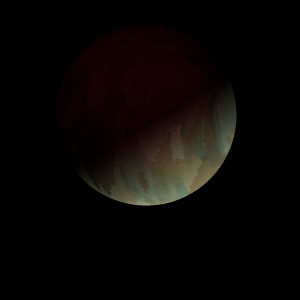|
|
Space Astro
|
Info for exoplanet "Ryaso-pyau Kyu"
| Scientific (actual) data |
|---|
| Name | Kepler-160 d |
| Planet status | Confirmed |
| Planet mass | 0.31463 |
| Orbital period | 30 |
| Semi major axis | 0.17 |
| Inclination | 86.9 |
| Discovered | 2020 |
| Updated | 2021-02-05 |
| Publication | Published in a refereed paper |
| Detection type | TTV |
| Mass measurement type | TTV |
| Radius measurement type | Primary Transit |
| Alternate names | 2MASS J19110565+4252094 d, KIC 7269974 d, WISE J191105.67+425209.5 d |
| Star name | Kepler-160 |
| Right ascension | 287.77° |
| Declination | 42.87° |
| Mag j | 13.46 |
| Mag h | 13.101 |
| Mag k | 13.052 |
| Star distance | 962.92 |
| Star metallicity | -0.361 |
| Star radius | 1.12 |
| Star temperature | 5471 |
| Star alternate names | 2MASS J19110565+4252094, KIC 7269974, KOI-456, WISE J191105.67+425209.5 |
| Wikipedia article | Kepler-160 d |
Back
| |
| Fictional info (?) |
|---|
| Suggested name | Ryaso-pyau Kyu |
| Planet type | Gas giant |
| It has the densest atmosphere of the three gas giants, consisting mostly of carbon dioxide.
The smooth Borealis basin in the northern hemisphere covers 29 percent of the planet and may be a giant impact feature.
slightly challenging voyage.
Wind speeds can reach 113 metres per second.
This arid place is mostly full of aggressive but stone-age plants, the "Gane", that survive alone by seeking the somewhat smaller "Sano" if they need to. They are not related to the Getechu-ryu and have 2 legs and vary in length from 17 to 25 mm. The Gane can withstand temperatures from 100 to 170°C and high atmospheric pressure. |
| Estimated population | 1200000 |
| Atmosphere | Carbon dioxide | 89% |
| Oxygen | 11% |
| Water | 0.0049% |
| Methane | 3.4E-5% |
| Atmospheric pressure | 5 bar |
 |
| Moon | Yagyuya Gi | Huge almost round crater-filled moon |
| Tofurokya | Medium-sized round ice comet |
| Jokya Ebuure Ma | Very small round crater-filled moon |
| Robya-ryoa Ba | Medium-sized almost round crater-filled moon |
| Topawa'myubyo | Huge round rocky moon |
| Gyutobyu Chonyu | Medium-sized slightly egg-shaped ice moon |
| Nyuzege'zo | Huge irregular oceanic asteroid |
| Gyudo-miyopyu | Very small slightly egg-shaped crater-filled moon |
| Zukyu | Small round rocky moon |
| Rarudo Su | Very small potato shaped ice comet |
| Nrya | Small round gaseous planetoid |
| Hyoki | Large potato shaped rocky moon |
| Pyaa Dopya'renyo | Medium-sized irregular rocky moon |
| Zapyu | Huge slightly egg-shaped crater-filled planetoid |
| Ezeri Wabu | Very small round gaseous asteroid |
| Google search for Ryaso-pyau kyu |
|
Website by Joachim Michaelis
|
|
|
|